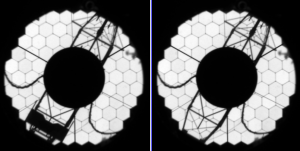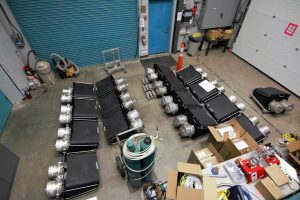In the last week we have had a few updates for two of our instruments. For VIRUS we are up to 29 working spectrographs. We actually have several more units but some of the oldest and slightly mis-behaving units have been sent back to Austin for realignment and recommissioning. For HPF we are thrilled to announce that a NIST laser comb has been installed in the calibration room in the HET basement. This allows us to send a picket fence of spectral features through a separate fiber next to the science fibers. During the data reduction and analysis of the HPF spectra they can look at the position of these pickets and determine how the instrument might be subtly moving and correct for it. So far it seems like it is working great.
Category Archives: Instruments
The week of November 6
A brief advertisement before we get into this week’s news: One of our Resident Astronomers is retiring. If you are a PhD astronomer and interested in working on one of the largest optical telescopes in the world doing cutting edge research please consider applying: https://utdirect.utexas.edu/apps/hr/jobs/nlogon/171020014209
This week the big changes to the telescope have been the removal of the Prime Focus Instrument Platform (PFIP) work platform and the arrival of 3 more VIRUS units. The PFIP work platform, as the name suggests, allowed us to drop people off to work on the PFIP. We will still be able to work on the PFIP but now we have to do it from the JLG worker-lift. The work platform covered up a number of mirrors (about 10% of the light collecting area) as can be seen in the images below taken with our pupil viewing camera.

Two images of the HET pupil taken with our pupil viewing camera before (left) and after (right) the PFIP work platform was removed.
With the delivery of 3 more VIRUS units we now have 28 working VIRUS units or 56 spectrographs or more than 12,000 fibers on the sky!
The week of October 16
The exciting news this week has been the arrival of the Habitable Planet Finder (HPF). This is the first of our new high resolution instruments and an instrument well suited to working in bright moon conditions. The HPF was designed and built by our Penn State partners and arrived on the 16th.
This instrument is designed for extremely high precision spectroscopy capable of detecting the reflex motion of stars as small earth sized planets go around them. To achieve that precision the instrument is housed in our temperature controlled basement at the HET inside a temperature controlled room inside a large temperature controlled vacuum chamber. All of these efforts allow them to control the temperature of the optics of the instrument at a level of 0.001 degrees Celsius.
After very carefully cleaning the enclosure that will house the vacuum chambered instrument the HPF team
was able to open their instrument and after a very through inspection proudly announced that they have just as many pieces of glass as they did in the assembly lab at Penn State (an optics joke). After a few final checks and the inclusion of their single moving part inside of the spectrograph they sealed up the vacuum chamber which, if things continue to go very well, may remain sealed for several years to come. The process of pumping the vacuum out of the large chamber took the rest of the weekend.
In the coming days and weeks the HPF team will monitor its stability, install the laser metrology system and get the systems ready for on-sky commissioning.
Quite an exhausting and exciting week at the HET!
The week of October 2nd
This week we are pleased to announce that a new VIRUS unit was installed in side two of the VIRUS enclosure. This brings us to 22 VIRUS units or 44 spectrographs. We also took a little time in the last engineering run to add on some valves to the vacuum fittings which will allow us to cold pump on the VIRUS units which takes far less time to do than to warm up and then repump which was our older methodology. Keeping 22 VIRUS units going is starting to be a little easier but still takes a lot of management.
In addition to the work on VIRUS, we have also installed in the coherent fiber bundles for the HPF. These coherent fiber bundles will be used to setup stars on HPF science fibers. HPF will arrive in the coming weeks and we are very excited to get our first high resolution instrument on sky in the coming months.
The week of September 18
We are in another 3 week science period but our big news this week is that we have been able to bring a few more VIRUS Units on-line which brings our total number of active units up to 21 units. Recall that a VIRUS unit is made up of 2 spectrographs so we now have 42 spectrographs on-line. These newest units are located in VIRUS enclosure 2 which means that we are now making use of both of the “saddle bags” which were installed at the HET as part of the Wide Field Upgrade. This makes the VIRUS closer to being ready for the main part of the HETDEX survey. As we add more Spectrograph units the system continues to get more complex with multiplexers and timing systems.
In some recent very clear nights we were able to observe 10 HETDEX shots (what we call a pointing for the survey) in a single night. This is a new record and our setup times are now typically below 5 minutes when moving from one shot to another. Further small milestones….
Week of April 2nd
The next few days are going to be very busy at the HET. The HET team along with help from Austin will be installing IFU’s for the second virus enclosure in preparation for more virus units to be installed. This involves stringing fiber cables from the enclosure up to the top of the tracker to be attached to the IHMP (Input Head Mounting Plate). The team will also be investigating and trying to remedy problems with the IHMP dither mechanism. During this time there will be no science or engineering related night work due to immobility of tracker, structure or dome for the IFU deployment.
Week of December 26th
It has been quiet during the day at the HET this week with day staff on holiday. If the weather clears the night staff will be plenty busy working through the queue. The current weather outlook for the week is cloudy with possible showers. Monday night we were able to do science through thin clouds and successfully collected data for many programs that do not require perfect seeing or zero cloud cover. The bulk of the science data collected in the beginning of the week has been with LRS2-B and LRS2-R. Fingers crossed the weather clears as we approach the new moon on Thursday.
The week of December 11
This week marks the first full week of the new trimester (December – March). During this period we will be observing for 2 weeks around the new moon with LRS2-B and LRS2-R and to a very limited extent the first 16 units of VIRUS for science projects from our partners. We have 27 separate projects from our 4 partners. During this first week of the new trimester we took data for 10 programs.
During the 2 weeks around the full moon we will be concentrating on engineering but we may if it does not impose any constraint on the engineering obtain a few science targets during grey and bright time.
It is good to be back online taking science data.
The week of August 15th

16 Virus units and their controllers lined up in the HET receiving bay. The controllers are the small boxes near the center of the image.
This week has been a busy one for the virus units at the HET. All of the virus units were removed from the enclosure, backfilled, pumped to vacuum and reinstalled. While doing this cooling fans were installed on all of the virus controllers to help keep the electronics cool. They hope that this will make the virus system a bit more stable.
The HET has been churning out lots of science during dark time this month as well. All groups that have submitted targets have received data!
The week of May 23
In the previous week the HET Board of Directors met and were generally happy with the progress being made on the HET. They are very eager for science operations to begin and have authorized the start of Early Science Operations starting July 1st. This will mean that HET member institutions will be able to submit requests to their local Telescope Allocation Committee in the coming weeks. The amount of time available will grow with time but is likely to start with 1 week per dark period. The instrument that will be available for Early Science Operations will be the new Low Resolution Spectrograph (LRS2).
In this week the HET continued with VIRUS commissioning during bright time with the addition of 7 new VIRUS units. This brings the number of spectrographs units (and IFUs) to 16. We will use these during commissioning in the coming dark run but we can already see that several of them will need some further engineering while others are very good.
The mirror team continues to swap mirrors into the array this week they swapped out 4 mirrors. The array now has an average coating age of 454 days with a swap rate of 1.7 segments/week.


